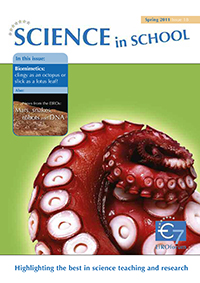Happy birthday, Science in School!
This issue of Science in School is rather special: it’s now five years since Science in School was launched, in March 2006.

Showing 10 results from a total of 20
This issue of Science in School is rather special: it’s now five years since Science in School was launched, in March 2006.
Scientific research is not a career that most people believe to be suitable for the blind, but such beliefs are changing. Biologist Geerat Vermeij explains that, whether you are blind or not, science is competitive, tedious and hard – and he loves it.
Uracil is well known as one of the bases used in RNA, but why is it not used in DNA – or is it? Angéla Békési and Beáta G Vértessy investigate.
Science on Stage brings together many of Europe’s most innovative and inspiring science teachers. Andrew Brown reviews some of the recent national activities.
Thanks to the determination of UK physics teacher David Richardson, increasing numbers of students in Rwandan schools are experiencing the delight of practical work. Vienna Leigh reports.
Physics teacher Keith Gibbs shares some of his many demonstrations and experiments for the physics classroom.
Relativity is, admittedly, a difficult subject to understand, even to science-oriented people. In Relativity: A Very Short Introduction, Russell Stannard has made an effort to explain relativity and its implications for the laws that govern the Universe in a way that can be understood by those with…
Moringas have long been known as miracle trees. Now scientists are investigating their properties in depth, as Sue Nelson and Marlene Rau report.
Have you ever longed for a hot drink or meal but had no fire or stove to hand? Marlene Rau presents two activities from the Lebensnaher Chemieunterricht portal that use chemical reactions to heat food – and to introduce the topic of exothermic reactions.
Happy birthday, Science in School!

To sea with a blind scientist
Uracil in DNA: error or signal?
Science on Stage: countdown to the international festival
Teacher solidarity: a UK-Rwandan physics project
The resourceful physics teacher
Relativity: A Very Short Introduction, By Russell Stannard
Moringa: the science behind the miracle tree
The heat is on: heating food and drinks with chemical energy